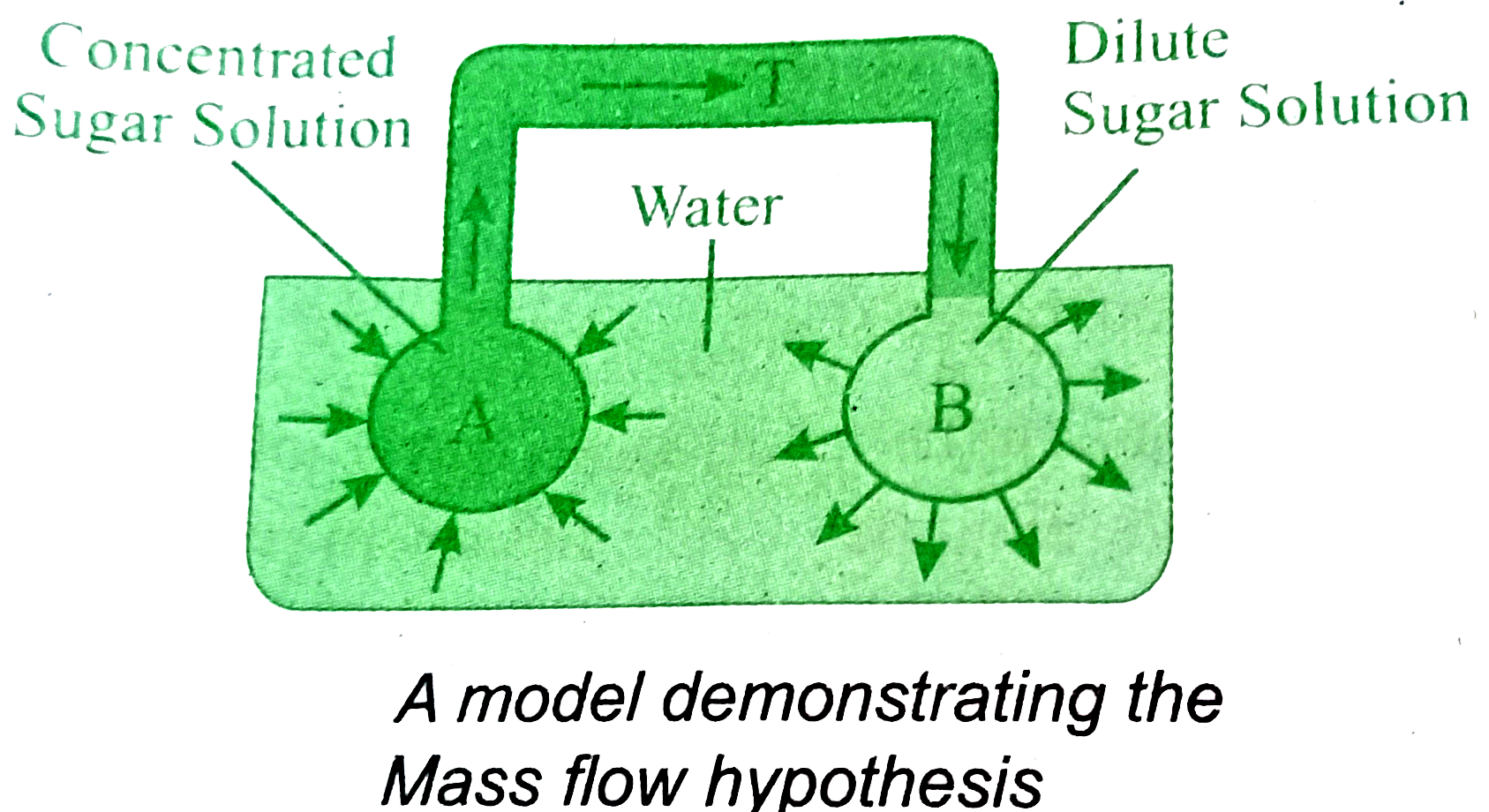Explain Munch mass flow hypothesis and its applications to plants. Solution in Tamil
Mass flow theory was First proposed by Munch (1930) and elaborated by Crafts (1938).According to this hypothsis ,organic substances or solutes move from the region of high osmotic pressure (from mesophyll) to the region of flow osomtic pressure along the turgr pressure gradient.The principle involved in this hypothesis can be explained by a simple physical system as shown in figure.
Two chambers "A" and "B" made up of semipermeable membranes are connected by tube "T" imersed in a reserevoir of water .Chamber "A" contains highly concentrated sugar solution while chamber "B"contains dillute sugar solution.The following changes were observed in the system.
(i)The high concentration sugar solution of chamber "A" is in hypertonic state which draws water from the reservoir by endosmosis.
(ii)Due to the continuous entry of water into chamber "A", tugor pressure is icreased .
(iii)Increase in turgor pressure in chamber "A"force ,the mass flow of sugar solution to chamber "B" through the tube "T"along turgor pressure gradient.
(iv)The movement of solute will continue till the solution in both condition and the system becomes inactive.
(v)However,if new sugar solution is added in chamber "A" , the system will start to run again.
A similar analogous system as given in the experiment exists in plant:Chamber"A" is analogous to mesophyll cells of the leaves which contain a higher concentration of food material in soluble form .In short"A" is the production point called "source".
Chamber "B" is analogous to cells of stem and roots where the food material is utilized. In short "B" is consumption end called "sink". Tube "T" is analogous to the sieve tube of phloem.
Mesphyll cells draw water from the xylem(reservoir of the experiment) to the leaf by endosmosis leading to increase in the turgor pressure of mesophyll cell.The turgor pressure in the cells of stem and the roots are comparatively and low and masse from mesoohyll through the phloem to the cells of stem and root along the gradient turgor pressure.In the cells of stem and roots ,the organic solutes are either consumed or converted into insoluble from and the excess wateris released into xylem (by turgor pressure gradient)through cambium.

(i)When a woody or herbaceous plant is girded,the sape contains high sugar containing exudates from cut end.
(ii)Positive concentration gradient disappeears when plants are defoliated.
Objection:
(i)This hypothesis explains the undirectional movement of solute is commonly observed in plants.
(ii)Osmotic pressure of mesophyll cells and that of root hair do not confirm the requirements.
(iii)This thoery gives passive role to sieve tube and protoplasm,while some workers demonstarted the involevement of ATP.
Topper's Solved these Questions
- BOOK - PREMIERS PUBLISHERSCHAPTER - TRANSPORTATION IN PLANTEXERCISE - Solution to activity4videos
TRANSPORTATION IN PLANT
- BOOK - PREMIERS PUBLISHERSCHAPTER - TRANSPORTATION IN PLANTEXERCISE - OTHER IMPORTANT QUESTIONS & ANSWERS (iii.Answer the following)19videos
TRANSPORTATION IN PLANT
- BOOK - PREMIERS PUBLISHERSCHAPTER - TISSUE LEVEL OF ORGANISATIONEXERCISE - SOLUTION TO TEXTUAL QUESTIONS6videos
TISSUE LEVEL OF ORGANISATION
- BOOK - PREMIERS PUBLISHERSCHAPTER - TRENDS IN ECONOMIC ZOOLOGYEXERCISE - SOLUTION TO TEXTUAL QUESTIONS1videos
TRENDS IN ECONOMIC ZOOLOGY
Similar Questions
Imbibition experiment :
Collect 5 gm of from from Drumstick tree or babool tree or Almond tree.Immerse in 100ml of water .After 24 hours observe the changes and discuss the results with your teacher.08:35View SolutionWhat are aquaporin ?
01:32View SolutionStraified epithelia are built for the protection or to resist abration. How are the simple epithelia better at ?
05:02View SolutionWhy are fish so efficient at converting feed to flesh?
03:51View SolutionExplain pressure flow hypothesis of translocation of sugars in plants.
03:45View SolutionMunch's mass flow hypothesis explains
07:22View Solutionपादपों में शर्करा के स्थानांतरण के दाब प्रवाह परिकल्पना की व्याख्या कीजिए।
03:15View Solutionमुन्च परिकल्पना क्या है? पादप-शरीर-क्रिया विज्ञान में इसका क्या महत्व है
04:11View SolutionExplain Munch mass flow hypothesis and its applications to plants.
02:22View SolutionExplain mass flow hypothesis?
04:16View SolutionExplain pressure flow hypothesis of translocation of sugars in plants.
06:50View SolutionExplain briefly Mass flow Hypothesis.
03:26View SolutionExplain Munch's hypothesis related to the transfer of organic solutes into plants.
02:13View SolutionState the Munch Mass flow hypothesis.
05:40View SolutionExplain pressure flow hypothesis of translocation of sugars in plants.
04:16View SolutionMunch's mass flow hypothesis explains
05:32View Solution

